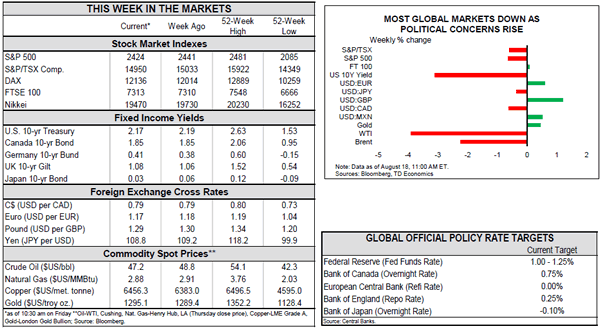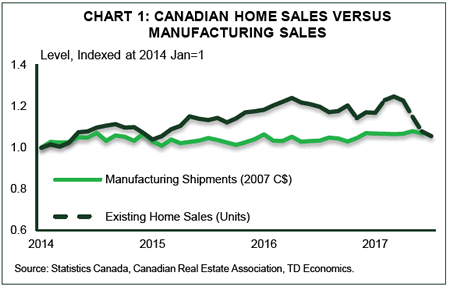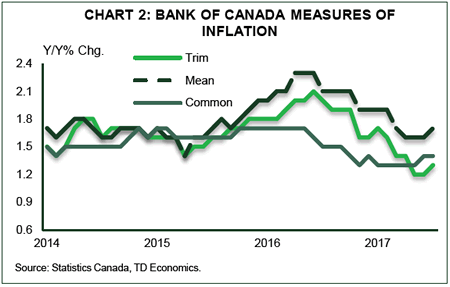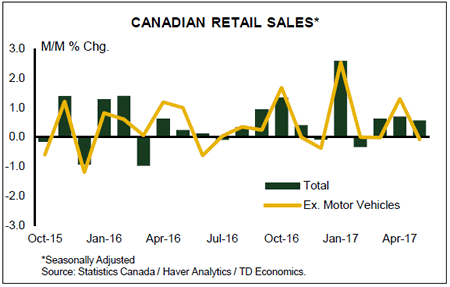U.S. Highlights
- A relatively good week for economic data was overshadowed by geopolitical events. Volatility spiked late in the week, the Dow suffered its largest one day loss since May on Thursday, and the 10-Year Treasury rallied to 2.17%.
- Investor nervousness is understandable, but there is little reason to doubt the ongoing economic expansion. U.S. retail sales rose by a robust 0.6% in July and were upwardly revised in June.
- Minutes from the FOMC’s July 26 rate announcement showed a Fed looking for proof that inflation is moving toward target, and agreeing that balance sheet reduction should begin soon (likely in September).
Canadian Highlights
- The Canadian housing market slowed for the fourth consecutive month in July on the back of government policy changes as well as deteriorated affordability related to elevated prices and rising mortgage rates.
- Other sectors of the economy are expected to help offset the economic impact from a slowdown in housing, but real GDP growth will likely slow from 3.7% in Q2 to 1.7% in Q3.
- The full year performance of the Canadian economy will remain solid, and economic slack soon fully absorbed. At the same time, inflation is starting to tick-up, which should keep the Bank of Canada on track to continue raising interest rates.

U.S. – Good Data Overwhelmed By Geopolitical Concerns
A relatively good week for economic data was overshadowed by geopolitical events and concerns about the economic leadership within the Trump administration. On Thursday, volatility spiked, equites saw their biggest declines since May (the Dow down 1.2%) and Treasuries rallied (U.S. 10-year fell to 2.19%) as investors sought the protection of safe assets.
The understandable nervousness among investors notwithstanding, there is little reason to doubt the ongoing economic expansion. Retail sales rose by a robust 0.6% in July and were upwardly revised in June. The details were encouraging with broad-based strength across categories. Given consistently strong job growth, accelerating wage growth and benign inflation, consumer spending should remain healthy over the second half of the year. We expect personal spending to rise by 3.0% in the third quarter. With additional support from business spending, real GDP should rise by about as much.
On the topic of inflation, the minutes from the Federal Open Market Committee’s July 25-26 meeting gave additional detail on how monetary policymakers are responding to its recent misses. The dilemma for policymakers is how to explain the continued downward drift in inflation in spite of ongoing tightening in the labor market. The minutes offered several possible explanations: a weakened relationship between resource slack and inflation, a lower natural rate of unemployment, greater lags in the relationship between economic tightening and inflation, and restraints on pricing power due to technology and globalization.
Overall, their faith is being tested, but it has not been lost. "Most participants thought that the [Phillips curve] framework remained valid" and still believe that inflation will return to target over the medium term. At a minimum however, they will need to see some proof that inflation is moving toward target in order to continue to push up policy rates.
The one area where the Fed was in general agreement was in the need to begin normalizing the balance sheet. While there was little new on this front in the discussions, the minutes confirmed previous announcements and statements by several Fed members. Importantly, the Fed does not see balance sheet normalization as substituting for increases in the federal funds rate, but rather hopes to proceed as inconspicuously as possible. Nonetheless, just as asset purchases helped to bring down yields, the unwinding of purchases is likely to put modest upward pressure on longer-term yields. Our forecast for Treasury yields over the next two years embeds a 10 to 20 basis point rise stemming directly from balance sheet reduction.
All of this assumes that the political situation in Washington remains stable. September will be a busy month for Congress, who has to pass an increase in the statutory debt ceiling and find a way to continue funding the government and avoid a shutdown. At the same time the administration will continue to push for personal and corporate tax reform. If Congress fails to reach accord on either the debt ceiling or government funding, we would expect increased volatility and additional losses in equity markets that still appear priced for perfection. As it has in the past, the financial and political damage would likely move politicians to quickly fall into line.


Canada – Soft Landing in Progress
It looks like it’s a wrap for Canada’s most recent housing boom. Existing home sales have now fallen for four consecutive months. The average existing home price declined 8.8% between its March peak and July, while home prices on a quality adjusted basis are down by 1.6% during the same timeframe.
Almost 80% of the decline in activity has occurred in Ontario. Existing home sales are down 44% in the GTA from their peak, and home values (on a quality adjusted basis) are down 5.3%. The sales-to-new listings ratio (a measure of supply-demand balance in the market) in the GTA has been sitting just above 40 for three months now, suggesting it was one of the softest markets across Canada, with prices typically declining in the GTA once this ratio dips below 45.
While the downturn in Ontario can be timed with the introduction of the Fair Housing Plan, it can also be attributed to a sharp deterioration in housing affordability over the last year due to rapid home price appreciations. Home prices in Ontario appreciated by an average of 6.0% per year since 1980, but rose by 15.6% in 2016 alone. These price gains were unsustainable set against income growth of just 4% per year, and the market was expected to moderate even without further housing policy changes.
Set against lofty valuations, the 40 basis point rise in 5-year mortgage rates since early July is likely going to keep the market from bouncing back even once the impact of policy rules wear out. As such, we anticipate that the Greater Toronto Area market is headed for a sustained 6% decline in average home prices next year. The recoveries that took hold earlier this year in Montreal, Vancouver, Calgary and Edmonton are also losing steam along with higher mortgage rates.
The housing slowdown expected over the rest of 2017 and into 2018 is expected to help contribute to a moderation in Canadian economic growth, but won’t derail it. For one, credit channels remain healthy and households continue to spend on a wide range on goods and services, despite having scaled back demand for housing. The manufacturing shipments report this week showed that sales have eased heading into the third quarter, but from lofty levels in Q2, with international trade is still expected to help contribute positively to economic growth throughout the rest of the year.
Once you put it all together, economic growth is expected to ease to 1.7% in Q3, following a solid print of 3.7% in the prior two quarters. This performance still puts Canada on track for average economic growth of 3.2% between Q3 2016 and Q3 2017 with the economy having now fully mopped up any economic slack that had accumulated since oil prices plummeted in 2014. This is starting to become evident in inflation data, with two of the three core inflation measures produced by the Bank of Canada ticking up moderately in July. As such, a slowing housing market is unlikely to push the Bank of Canada onto the sidelines in the near-term should it remain a soft-landing scenario.


Canada: Upcoming Key Economic Releases
Canadian Retail Sales – June
Release Date: August 22, 2017
Previous Result: 0.6% m/m, ex-autos -0.1% m/m
TD Forecast: -0.4% m/m, ex-autos -0.6% m/m
Consensus: N/A
Retail sales are forecast to give back 0.4% in June following a number of upbeat retail reports. Gasoline station sales should serve as the primary catalyst for the pullback after another sizeable decline in the price at the pump, while motor vehicle sales could see an incremental gain from record levels. This should leave ex-auto sales weaker at -0.6% m/m, though much of that is driven by the aforementioned drop in gasoline sales. Broader measures of retail sales should see little change though household furnishings are likely to decline from May on the slowdown in the Toronto housing market. However, we do not think this will have a wider spillover to total retail sales given its isolated geographical impact and the fact that measures of consumer sentiment have remained upbeat. Because seasonally adjusted consumer prices were unchanged in June, real retail sales should come in near the nominal print.













